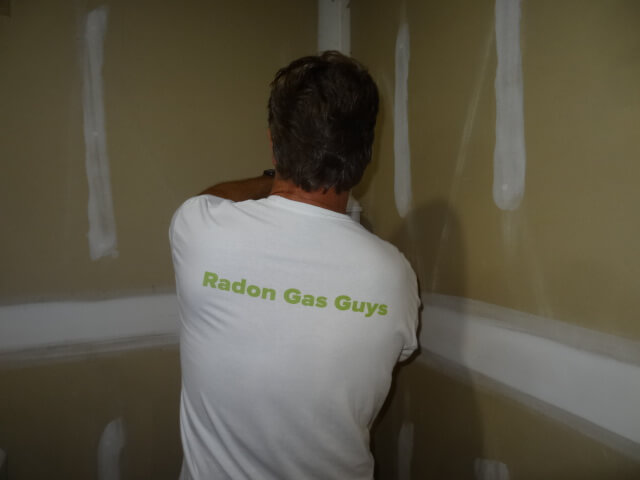How Radon Gas Enters the Home
Radon is an odourless, colourless tasteless gas that poses a serious health hazard when people are exposed to high levels over time. In this article, we’ll take a look at how radon gas enters the home in the first place, how to test for it and what you can do if you have high levels in your house.
What Is Radon Gas?
Before we explore how radon gas enters the home, it’s important to fully understand what radon gas is. Radon is a colourless, odourless and tasteless gas. Radon gas, like carbon monoxide, is considered an indoor air pollutant and health hazard. However, unlike carbon monoxide, which can become deadly very quickly, radon gas impacts your health over a long period of time.

Some level of radon gas is found in all homes in Ontario. Why? Radon gas naturally occurs in the environment. The gas is produced when the heavy metal uranium decays. Uranium is found in the earth’s crust and some areas have higher amounts than others.
As uranium decays, it releases a radioactive gas–this gas is radon. Since uranium decays underground, radon is emitted from the ground. Because of this, the highest concentration of radon is usually found in basements, however, any area of the home can be affected.
How Radon Gas Enters The Home
There are a number of ways that radon gas enters the home. In most cases, radon gas will seep into your home from your basement (or another lower level, such as a crawlspace). Some of the most common ways that high concentrations of radon gas get into the home include:
- Cracks in your foundation floor
- Cracks in your foundational walls
- Poorly sealed windows or other openings
- Gaps around hydro entries or sump pumps
- Through floor drains
- Spaces or cavities inside walls
- Gaps around support posts or construction joints
Even minor infrastructure issues, like a small crack or gap can cause radon to seep into your home. Some areas also have high-occurring levels of radon due to the natural environment and geography. For example, much of Southern Ontario has naturally high levels of radon gas.
Between 2009 and 2011, Health Canada conducted Canada-wide surveys to monitor the level of radon gas in the average home. This data was collected for cities across the nation. See the map below to find out the results for Southern Ontario.

Most of Southern Ontario is in a designated “Zone 1 – High” area, meaning that there is a higher likelihood your home will have elevated levels of radon gas in it. Other areas designed Zone 2 and Zone 3 are less likely to have elevated levels. However, each home is unique. Your neighbour could have high levels of radon gas while your home has lower levels. There are so many factors that can increase or decrease your chances of having high levels of radon in your home.
What is Considered “High” Radon Levels?
It is not possible to entirely avoid radon gas. It is everywhere, and all homes in Canada have some level of radon gas in them. Uranium naturally occurs in the environment and will continue to go through the decomposition cycle, creating radon gas. There is no guaranteed safe level of radon gas exposure, however, we know that high levels are unsafe. The Canadian guideline for radon gas in the home is 200 Bq/m3. When radon gas levels in the home exceed 200 Bq/m3, Health Canada considers that a hazard.
If you conduct a test and find out your home has higher than the Canadian guideline, it is important to contact a radon gas mitigation company. Below, we’ll discuss how to conduct a test and what to do if you find high levels of radon gas in your home. But first, let’s take a further look at why radon gas can be so dangerous.
Radon Gas and Your Health
Radon is a radioactive gas. Radiation exposure can damage our cells and lead to an increased chance of developing cancer. Prolonged exposure to radon gas can damage the tissue in your lungs. Did you know that radon gas is number one cause of lung cancer in non-smoking individuals?

When radon gas is found in high levels in your home, you will breathe it in along with oxygen. This radioactive gas then decays into radioactive particles, and these particles emit energy inside of your lungs. This process causes damage to your lung tissue. If damage to your lung tissue happens consistently over time, it increases the chance that you will get lung cancer.
Are there any symptoms of radon gas exposure?
Unlike carbon monoxide, which can cause symptoms upon exposure, there are no symptoms of radon gas exposure. Sadly, the only symptoms associated with radon gas exposure are lung cancer symptoms. Symptoms of lung cancer include:
- Difficulty breathing and shortness of breath
- New or worsening cough
- Hoarseness
- Pain or tightness in the chest
- Difficulty swallowing
- Coughing blood
Because there are no acute symptoms of radon gas exposure and the gas itself is odourless, colourless and tasteless, it is extremely important to get your home tested. There is no way of knowing if your home has high levels of radon gas in it without conducting a test.
Radon Gas Tests
To accurately test for radon gas in your home, you need to conduct a test over time. Radon gas levels can significantly fluctuate, so one high or one low reading won’t really tell you much. You need to conduct a test for a minimum of three months (91 days) to get an accurate reading.
One of the most common and easiest ways to test for radon is by purchasing and using a dosimeter. It is important to install the dosimeter on the lowest level of your home that you spend at least a few hours on each day. To get the most accurate reading, you will want to test a part of your home that you actually use. For example, if you only have a crawlspace that you use for storage and rarely go into, it’s best to test a floor up.

Testing is very easy and is recommended for all households in Southern Ontario. You can easily purchase a 91-day dosimeter online and install it yourself at home. You can also contact a radon gas mitigation company to install the kit for you. Although these kits are designed to be easily used by homeowners, some families prefer to work with the professionals–because the test takes 91 days to complete, you want to make sure it is installed correctly and on the right level of your home. If you make a mistake, you will have to re-do the test and wait another three months for your results!
There are also other testing options. For example, you could purchase a more complex air quality monitor such as the AirThings Corentium Monitor. This device shows you both short-term and long-term radon readings, giving you a thorough insight into the radon levels of your home. Learn more about different testing options and packages here.
Radon Gas Removal
What happens if there are high levels of radon gas in your home? If you’ve conducted a test and found that your home has high levels of radon gas, you may feel overwhelmed. Fortunately, when you work with a radon gas mitigation company, they can easily install a radon mitigation system.
When you call a company like the Radon Gas Guys, they will come to your home conduct a thorough assessment. High levels of radon gas are often associated with other issues in your home. The Radon Gas Guys will not only thoroughly assess your basement (or other area with high radon levels) and fix the problem. Installing a mitigation system without addressing larger issues such as gaps and cracks is not a proper fix.
The experienced team at the Radon Gas Guys will look for any issues like foundation floor or wall cracks, gaps around sump pumps or poorly sealed windows and address them to ensure excess radon gas does not continue to enter your home. After that, it’s time to install the radon mitigation system. The system is often installed in the basement. However, it could be installed on a different level depending on your home’s unique layout.

The radon gas mitigation system is actually a fairly simple system and process. The system is installed within a day and does not cause a significant disturbance to the rest of your home. The mitigation system consists primarily of a pipe and fan. This system is usually installed into the foundation of your home and removes radon gas by sucking it out from your indoor space and exhausting it outdoors.
Some homeowners think that radon gas is an “old home” problem–but that’s not true. The age of your home does not correlate with high or low levels of radon. However, if your home is less than seven years old, your Tarion Warranty will cover the installation of a radon mitigation system. This is good news! And, it means that if you are living in a new home, it’s a good idea to conduct a test as soon as possible to ensure the system is covered under warranty.
Get Accurate Testing and Radon Mitigation From Radon Gas Guys

As you now know, there are many ways how radon gas enters the home. Because all homes in Ontario have some level of radon gas in them, it’s important to conduct a test to see what’s going on in your house. We also understand that learning about radon gas can feel overwhelming! At Radon Gas Guys, we want to help you feel comfortable from the start. We are committed to the health and safety of homeowners in Southern Ontario. We want to help you and your family stay safe in your home with effective radon removal services.
If you are worried about high levels of radon gas in your home and are ready for radon gas removal, give us a call. We would be happy to discuss your options and get a plan in place to reduce the high levels that could make you and your family sick.
Rick was great to deal with. The quote was quick and the job was done quick. My number averaged about 600 and I’m now down into the 20s which is perfect. He also informed me of some other issues within my house to fix.
Goldcap100, Google Reviews